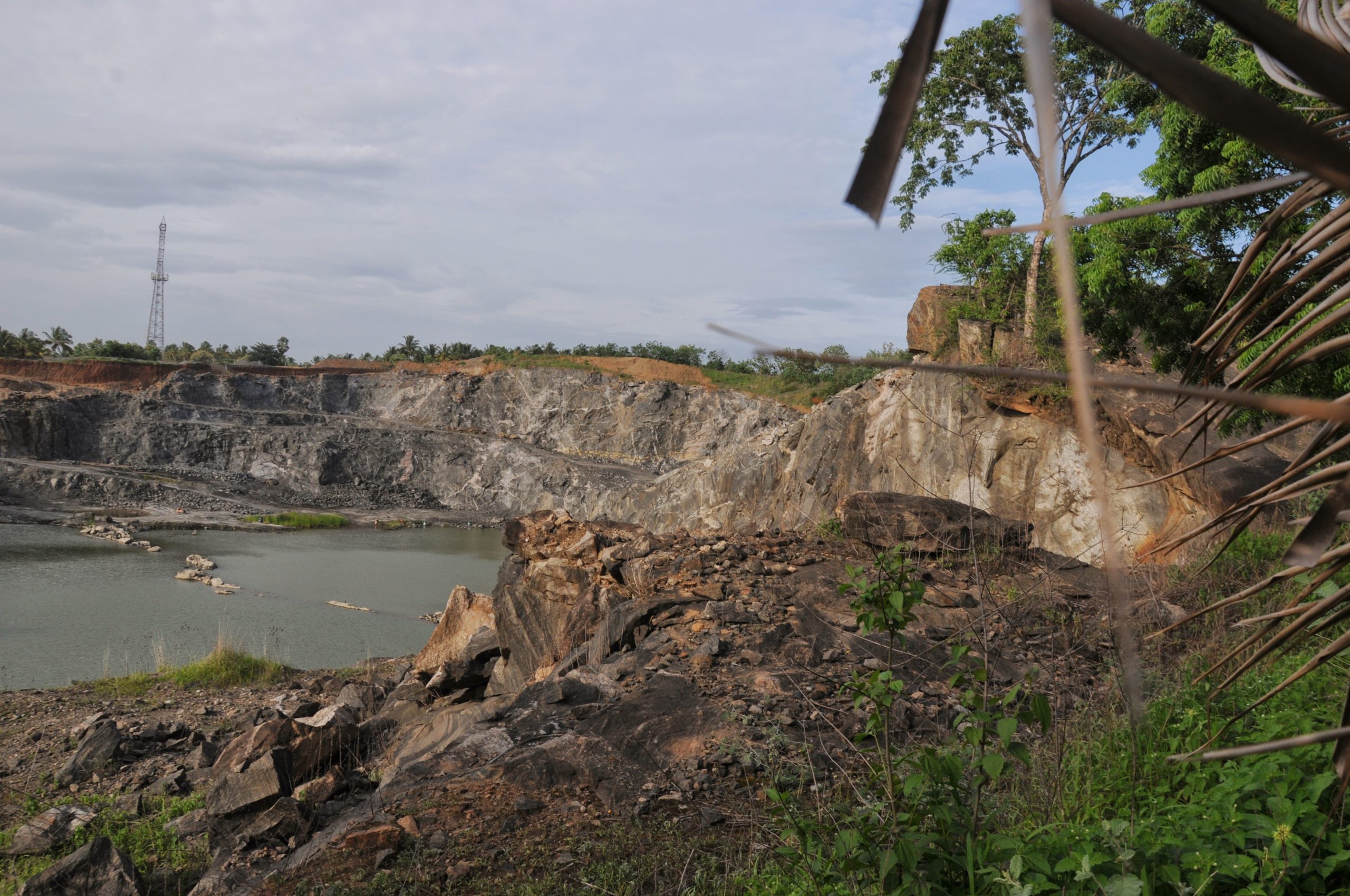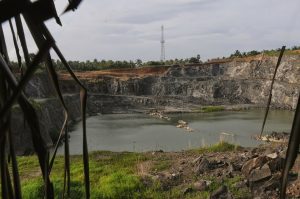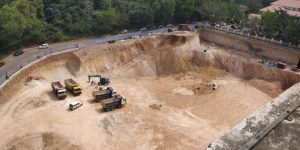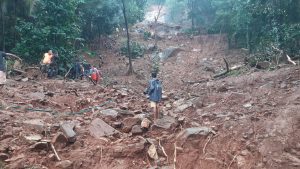Legal and illegal quarries are cited as the reason for the large number of landslides occurring every rainy season across Kerala.

A major granite quarry located at Muthalamada, a highly vulnerable area of Western Ghats. (KA Shaji/South First)
The Kanichar panchayat on the eastern borders of Kerala’s Kannur district witnessed devastating landslides on 31 July, claiming three lives, including that of a two-and-a-half-year-old girl.
Disaster management experts who visited the panchayat after the incident pointed to indiscriminate quarrying in the hills of the region as the reason for the intensity of the landslide.
They also pointed out that vast amounts of water are stored inside the quarries at present, and they pose a continuing threat to the panchayat.
Local Affairs Minister MV Govindan, who visited the panchayat where the landslide ruined vast stretches of agricultural lands and over 12 houses, directed the district collector to issue an order to the quarry management not to resume operations till the situation improved.
Kerala has 5,924 active stone quarries, but just 750 of them have the required permission of the Department of Mining and Geology.
Legal and illegal quarries are cited as the reason for the large number of landslides occurring every rainy season across the state.
As per data presented in the Lok Sabha on 27 July by Union Minister of State for Science Technology and Earth Sciences Jitendra Singh, Kerala recorded 2,239 out of the 3,782 significant landslides that occurred across the country in the last seven years.

Kerala has a total of 5,924 functioning stone quarries, but only 750 of them have the mandatory permission from the Department of Mining and Geology. (KA Shaji/South First)
Going by that data, Kerala alone recorded over 1,000 mega landslides between 2015 and 2022.
West Bengal, in second position, witnessed only 376 landslides in the same period, while Tamil Nadu reported 196 and Karnataka witnessed 194. Jammu Kashmir was in the fifth position with 184 landslides.
Experts said quarries play a key role in the landslides in Kerala, along with high-intensity rainfalls in specific areas.
According to TV Sajeev of the Kerala Forest Research Institute (KFRI), who has studied the topic, most landslides in Kerala occur in areas that have active stone quarries within a one-km radius.
Across the state, quarries have been built by removing the surface soil, which impacts the natural absorption of water into the soil — this, in turn, causes mudslides and landslides
Though the Kerala Assembly’s environmental affairs panel has mooted a comprehensive mining policy that adheres to the guidelines issued by the National Green Tribual and the Supreme Court, the state government has yet to address the issue seriously.
The panel has suggested government control over all mining activities in the state, as well as an end to the prevailing practice of issuing quarrying licenses to individuals.
Stone quarries are a proven threat, and Kerala has to address the issue seriously, Sajeev told South First.
It has been two years since Sajeev and TJ Alex, a fellow scientist at KFRI, initiated a survey that identified 33 stone quarries in the 10-kilometre radius of Kavalappara, a highly vulnerable portion of the Western Ghats, where 59 people were buried alive in a massive landslide on 8 August, 2019.
”Kerala has witnessed climate-change-induced heavy rains every July, August, and September since 2018. But satellite images of the areas where landslides occurred clearly explain what aggravated the disaster,” said Sajeev.
“Our survey found that the existing quarries changed the landscape of the respective hill regions and made the hills unstable. In most places, permissions for quarry operation is granted without conducting any environmental-impact study,” he added.

A functional quarry in Wayanad. (KA Shaji/South First)
In a report they submitted to the state government in November 2021, Alex and Sajeev strongly recommended the need for specific studies before permitting mining in environmentally sensitive areas of the Western Ghats.
“Mining is unavoidable as it helps construction activities. But it must not be at the cost of the people’s environment, life, livelihood, and safety,” the report pointed out.
The report noted that Kerala’s stone quarries are spread over 7,157 hectares of the Western Ghats, especially in the Wayanad, Pathanamthitta, Malappuram, Idukki, and Kannur districts.
Northern Kerala has 2,438 quarries, while central Kerala has 1,969, and south Kerala has 1,517. While most of the quarries are medium-sized, there are 19 large-scale quarries, each conducting blasting and mining on more than 20 hectares of land.
There are 70 other large-scale quarries, each operating in over 10 hectares of land.
According to N Badusha, president of Wayanad Prakrithi Samrakshana Samithy, quarries — along with an underground-water erosion phenomenon called “soil piping” — are making Kerala more vulnerable to the climate crisis.
During the last three monsoons, the state government issued directives preventing all kinds of mining activities in the state. But the same government revoked those orders whenever the rains receded.
Three months after the floods of 2018, the Union government approved the state’s request to exclude 4,000 square kilometres of land in Kerala from the ambit of a 2013 law that banned quarrying in ecologically sensitive areas.
As many as 147 new quarries have come up in this area since August 2018, when the state witnessed massive floods.
The National Green Tribunal (NGT) ordered the state government three years ago to permit quarrying only if it was 200 metres away from public buildings and houses in case the activity involves blasts. The tribunal said the distance could be 100 metres if the mining involved no blasting.
However, the government showed no hurry to implement the order, giving the quarry operators ample time to move the Kerala High Court and obtain a stay.
The court ordered that quarries during their valid period of license or lease need not fulfil the prescribed distance norm of 200 metres.
Despite demands by green groups, the government did nothing to approach the Supreme Court to quash the high court order.

Scene of a landslide at Kanichar near Kannur. (South First)
According to the high court, quarries must maintain just the distance norm of a 50-metre distance set down in the Kerala Mineral Concession Rules.
In a later observation, the NGT found that the state government’s permitting of quarries at a distance of 50 metres from habitations was highly improper and unscientific.
The tribunal said it would harm the environment and public health whenever blasts occurred.
In this context, the Kerala Assembly’s panel on the environment suggested that the state government formulate a comprehensive mining policy to bring all existing quarries under government control.
The committee has also wanted the National Pollution Control Board to issue more stringent conditions for quarry operations, mainly regarding their location at a proper distance from all villages and environmentally sensitive forest areas.
“The prevailing grim situation forces us to think of ways that can mitigate the climate crisis. However, the state government and its various enforcement agencies remain silent about the blatant violations happening around in the name of quarrying,” environmental activist Vinod Payyada told South First.
It’s high time the government accept the panel’s recommendations completely and bring all quarries in the state under its control,” Payyada added.

Jul 26, 2024

Jul 26, 2024

Jul 25, 2024

Jul 25, 2024

Jul 25, 2024

Jul 24, 2024